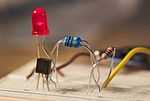Direct current/Transistor
< Direct current| Direct current |
|---|
 |
| General electronics |
|
|
|
| | Search for Direct current/Transistor on Wikipedia. |
A transistor is a three terminal electronic component which is made of semiconductor material. Transistors are fundamentally current amplifiers. The transistor is essentially a resistor which allows current to flow. The word transistor is a contraction of current-transferring resistor. The three parts of a transistor are the base, collector, and emitter.
Transistor is a two junction device. Formed by joining two semi-conducting material , one is positive nature denoted by capital P , one is negative in nature denoted by N in the arrangement like below:
1) PNP , one negative semi-conductor (usually Si) in between two positive semi-conductor (usually Ge) . This kind of arrangement is called PNP Transistor
- о--[P|N|P]--о
2) NPN , one positive semi-conductor (usually Ge) in between two negative semi-conductor (usually Si) . This kind of arrangement is called NPN Transistor
- о--[N|P|N]--о
The difference can be only seen by the arrow at the emitter
With the right connection, by connecting transistor with resistor(s) Transistor can acts as an amplifier, a switch, a buffer.
A transistor has three terminals namely, emitter, base and collector. Emitter is the region thru which majority carriers enter the transistor. Emitter is heavily doped. Base is the middle layer and it is very lightly doped. Collector is wide and moderately doped.